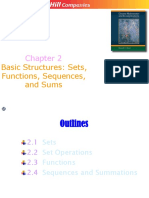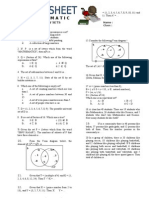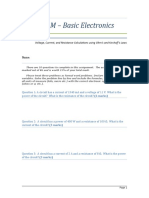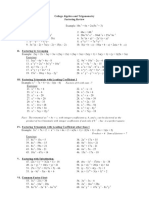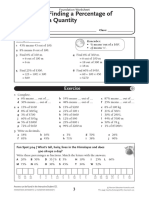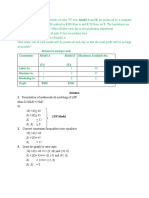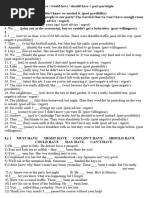Chapter 1 Sets
Chapter 1 Sets
Uploaded by
endeavour909897Copyright:
Available Formats
Chapter 1 Sets
Chapter 1 Sets
Uploaded by
endeavour909897Copyright
Available Formats
Share this document
Did you find this document useful?
Is this content inappropriate?
Copyright:
Available Formats
Chapter 1 Sets
Chapter 1 Sets
Uploaded by
endeavour909897Copyright:
Available Formats
CS17D01-01
1
1.1
Set Language and Notation
Denitions
Set is a collection of distinct objects. The individual object which belongs to the set is called element or member of the set. Empty set is a set that contains no elements. Empty set is also known as null set, denoted as {} or .
1.2
Describing Sets
In Mathematics, a set is denoted as a capital letter. The elements of the sets are described inside curly brackets. There are two ways in describing a set; Explicitly listing the elements of the set A={0, 1, 2, 3} B={cat, dog, dolphin} C={Physics, Chemistry, Biology, Mathematics} Describing the elements characteristic of the set D={prime numbers less than 25} E={whole numbers greater than 5} F ={x:x is a multiple of 3} G={y:y is a perfect square number} Note that the colon in the example is read as "such that".
1.3
Number of Elements
Given a set X, the number of elements in set X is denoted as n(X). Set C as described above has 4 elements, thus n(C) = 4. The empty set has 0 elements, hence n() = 0.
1.4
Membership
The Greek letter epsilon, means is a member of, and means is not a member of. / For example, the set B above, cat B while buttery B. /
1.5
Further Denitions
Equal Sets Two sets are equal if and only if they have precisely the same elements. For example, A={x:x is even number between 3 and 9} and B={4, 6, 8}. Every element in A is a member of set B and every element in B is a member of set A. Hence, it can be concluded that A=B.
...where abilities come alive
[FP] [9/2012] Maths Hub
CS17D01-01
Disjoint Sets Two sets are disjoint if and only if there are no common elements at all. For example, A={x:x is even number} and B={y:y is odd number}. There are no common elements between A and B as every elements in A is divisible by 2, while every elements in B is not divisible by 2. Hence, it can be concluded that A and B are disjoint sets. Universal Set Universal set is the set that contains every element of all the sets under consideration. Universal set is denoted as Greek letter xi, . For example, If A={0, 1, 2}, B={4, 7, 10}, and C={book, pen, pencil}, then ={0, 1, 2, 4, 7, 10, book, pen, pencil}. Complement of a Set The complement of set X is denoted as X . Set X is a set that contains the elements that are not in X. For example, if ={1, 2, 3, 4, 5} and X={1, 2}, then X ={3, 4, 5}. Subsets Given two sets A and B, A is said to be a subset of B if every elements in A is also a member of set B. There are two types of subset; Trivial Subsets Trivial subsets are subsets which can be determined without knowing the elements of the set. For every non-empty set, there are two trivial subsets, which is the set itself and empty set. The reasons follow from the denition of equal sets and empty set. Suppose that B is the subset of A. If B = A, then each element in B must be in set A. On the other hand, if B = , then every member in B (which does not exist at all) will trivially be the member in A. Proper Subsets Proper subsets are subsets in which the number of elements in the subset is strictly lesser than the number of elements in the set. In other words, there exists at least one element in the set which is not the member of the proper subset. Note that empty set is trivial and proper subset for every non-empty subset. There are two subset notations, and . These notations are analogous to < and . If A B, then A is said to be the proper subset of B, which implies n(A) < n(B). If A B, then either A B or A = B, which implies n(A) n(B). For example, given sets A={2, 4, 6} B={even numbers between 1 and 7} C={x:x is divisible by 2, and 2 < x < 10} D= It can be observed that A = B, which implies A is trivial subsets of B and vice versa. In other words, A B and B A. ...where abilities come alive [FP] [9/2012] Maths Hub
CS17D01-01 D is a trivial subset of A, B, and C.
A and B are proper subset of C as every element in A and B is in C, but 0, 8 C but 0, 8 A, B. / Suppose that a set contains n many elements, then the total number of subsets is 2n . For example, if A={a, b, c}, then its subsets are , {a}, {b}, {c}, {a, b}, {a, c}, {b, c}, {a, b, c}. Note that the set contains 3 elements, its number of subsets is 23 .
2
2.1
Intersection and Unions of Sets and Venn Diagram
Intersection of Sets
Given two sets A and B, the intersection of sets A and B is a set that contains elements which are common to both sets A and B. The intersection of sets A and B is denoted as A B. For example, given sets A={1, 4, 7, 10, 13} and B={2, 4, 8, 10, 11}, A B={4, 10}.
2.2
Union of Sets
Given two sets A and B, the union of sets A and B is a set that contains elements which are member of A or B. The union of sets A and B is denoted as A B. For example, given sets X={1, 3, 5, 7} and Y ={1, 2, 4, 8}, X Y ={1, 2, 3, 4, 5, 7, 8}.
2.3
Properties of Intersection and Union of Sets
Commutative Property AB =BA AB =BA Identity Property A=A=A A=A= Associative Property (A B) C = A (B C) (A B) C = A (B C) Distributive Property A (B C) = (A B) (A C) A (B C) = (A B) (A C)
2.4
Venn Diagram
Venn diagram is a diagram that shows all possible relationships between collection of sets. In Venn diagram, a rectangle is used to represent a universal set, while circles or ovals inside the rectangle is used to denote its subsets. For example, given sets ={a, b, c, d, e, f, g, h}
...where abilities come alive
[FP] [9/2012] Maths Hub
CS17D01-01 A={a} B={a, f, g ,h} C={b, c, d, f, g}
Relationship between sets can easily be explained with Venn diagram. Given two nonempty sets A and B with universal set , there are three possibilities; 1. B is the subset of A
BA AB =B AB =A n(A B) = n(A) 2. There are some common elements between A and B
AB = n(A B) > 0 3. A and B are disjoint sets
...where abilities come alive
[FP] [9/2012] Maths Hub
CS17D01-01
AB = n(A B) = 0
Practice Problems
1. List down the elements of the following sets. (a) A={x:x is divisible by 2, 3 x 10} (b) B={x:x is the name of month beginning with letter J} (c) C={Prime numbers between 20 to 34} (d) D={Perfect square numbers which are prime numbers} (e) E={Leap years between 1990 and 2013} Answer : (a) A={-2, 0, 2, 4, 6, 8, 10} (b) B={January, June, July} (c) C={23, 29, 31} (d) D = (e) E={1992, 1996, 2000, 2004, 2008, 2012} 2. Given that A={a, b, c}, B={all vowels in alphabet}, and C={e, f, g}. Determine (a) A B (b) A B C (c) A B C (d) (A B) C (e) (A B) C Answer : (a) A B={a} (b) A B C={a, b, c, e, f, g, i, o, u} (c) A B C = (d) (A B) C={e} (e) (A B) C={a, e, f, g} 3. Determine whether the following statements are true or false. State the reason if it is a false statement.
...where abilities come alive
[FP] [9/2012] Maths Hub
CS17D01-01
(a) The number of elements in a set is strictly greater than the number of elements of its subsets. (b) If A={1,2} and B={1,2,3,4}, then B A. (c) There are four elements in the set C={x:x 8, x is a prime number} (d) If C={a, b, c, d} and D={d, e, f}, then C D={d}. (e) Given two non-empty sets A and B, n(A B) n(A) + n(B) (f) Universal set is a union of all sets which are under consideration. (g) If A={a , b, c}, then abc A (h) If B={1, 2, 4}, then {1,4} B. (i) If F ={a, b, c}, G={d, b, a}, H={a, r, t}, then F G H={a}. (j) Given two disjoint sets A and B, then n(A B)=n(A) + n(B). Answer : (a) False, a set is also a subset of itself. (b) False, A B. (c) True, C={2, 3, 5, 7}. Hence, n(C) = 4 (d) False, C D={a, b, c, d, e, f}. (e) False, suppose that n(A) = x, x 0, and B = A. n(A B) = n(A) = x, while n(A) + n(B) = 2n(A) = 2x. (f) True, based on the denition of universal set. (g) False, the three elements in A is a, b, and c. (h) True (i) True (j) True 4. Given ={a:a is a whole number, 4 a 36}, A={x:x is a perfect square number and 1 x2 40}, B={y:y is divisible by 4, 4 y 30}, and C={z:z is divisible by 3, 10 z 37}. Determine (a) A B (b) B C (c) A B C (d) (A B) C (e) A (B C) Answer : ={-4, -3, -2, ..., 35, 36} A={1, 4, 9, 16, 25, 36} B={-4, 0, 4, 8, 12, 16, 20, 24, 28} C={12, 15, 18, 21, 24, 27, 30, 33, 36} (a) A B={4, 16} (b) B C={15, 18, 21, 27, 30, 33, 36} ...where abilities come alive [FP] [9/2012] Maths Hub
CS17D01-01 (c) A B C = (d) (A B) C={12, 24, 36} (e) A (B C)={4, 16, 36} 5. Fill in the correct symbols (, , , =) between these sets / (a) {Tuesday, Thursday} . . . {Days of week beginning with letter M or T } (b) {0, 1, 2} . . . {0, 1, 2, 3, 5} (c) {prime numbers between 2 and 10} . . . {odd numbers between 2 and 8} (d) {whole numbers ending with 0} . . . {whole numbers divisible by 5} (e) 113 . . . {prime numbers} (f) . . . {0} (g) {whole numbers divisible by 12} . . . {whole numbers divisible by 3} (h) {a} . . . {{a}, b, {b, c}} (i) a . . . {ab, ac, bc} (j) {a,b} . . . {{a,b},{c,d}} Answer : (a) (b) (c) = (d) (e) (f) (g) (h) (i) / (j)
6. Simplify the following expressions if A and B are disjoint sets and C is the subset of A (a) (A B) C (b) (A B) C (c) (A C) B (d) C B (e) A B Answer : (a) (b) C (c) (d) (e) B 7. Shade the region representing the following sets
...where abilities come alive
[FP] [9/2012] Maths Hub
CS17D01-01 (a) A B C
(b) A (B C )
(c) (A C) (B C)
(d) (A B) (C B)
(e) (A B ) C
8. Given two sets A and B, where n() = 40, n(A) = 24, n(B) = 28, and n(A B ) = 8. ...where abilities come alive [FP] [9/2012] Maths Hub
CS17D01-01 (a) Determine n(A B) (b) Sketch the Venn diagram illustration Answer : (a) Suppose that n(A B) = x, then n(A B ) = n(A) n(A B) = 24 x n(B A ) = n(B) n(A B) = 28 x n(A B ) + n(A B) + n(A B) + n(A B) = 40 60 x = 40 x = 20 (b) The Venn diagram :
9. Suppose that a class consists of 35 many students. It is known that each student should join at least one Co-Curricular Activities. Given that there 23 student join badminton club and there are 9 students join both badminton club and basketball club. (a) Determine the number of students who only join basketball club (b) Sketch the Venn diagram illustration Answer : (a) Suppose that A is the set of students who join badminton club, and B is the set of students who join basketball club. From the question, we obtain n(A) = 23, n(A B) = 9, and n(A B) = 0. Let n(A B) = x, n(A B ) = n(A) n(A B) = 14 n(A B ) + n(A B) + n(A B) + n(A B) = 35 23 + x = 35 x = 12 ...where abilities come alive [FP] [9/2012] Maths Hub
CS17D01-01 (b) The Venn diagram :
10
10. Sketch the Venn diagrams of the following sets (a) n() = 45, n(A) = 25, n(A B) = 5, n(C) = 7, C A, B C = , and n(A B C) = 0 (b) n() = 42, n(A) = 13, n(B) = 11, n(C) = 18, (A C) = 3, n(B C) = 4, AB = (c) n() = 31, n(A) = 14, n(B) = 20, n(C) = 20, n(A B) = 7, n(A C) = 6, n(B C) = 15, A B C = , n(A B C) = 0 Answer : (a) The Venn diagram
(b) The Venn diagram
(c) The Venn diagram
...where abilities come alive
[FP] [9/2012] Maths Hub
CS17D01-01
11
11. Given that n() = 30, n(A) = 15, n(B) = 19, determine the largest and the smallest values of n(A B). Sketch the Venn diagrams for both cases. Answer : n(A B) reaches the largest value when A is the subset of B. Hence, n(A B) = n(A) = 15.
n(A B) reaches the smallest value when n(A B) = 0. Hence, n(A B) = n(A) + n(B) n() = 4.
12. Given that ={positive whole numbers}, A={factors of 4}, B={factors of 6}, C={factors of 12}, D={factors of 9}. Determine (a) A B (b) B C (c) C D Answer : A={1, 2, 4} B={1, 2, 3, 6} C={1, 2, 3, 4, 6, 12} D={1, 3, 9} (a) A B={1, 2, 3, 4, 6} (b) B C={1, 2, 3, 6} (c) C D={1, 3}
...where abilities come alive
[FP] [9/2012] Maths Hub
You might also like
- Honors Calculus Midterm ExamDocument4 pagesHonors Calculus Midterm Examapi-317867476No ratings yet
- Prelude Guide QuestionsDocument3 pagesPrelude Guide QuestionsLara Suarez80% (25)
- CLOSER Script (Partly)Document2 pagesCLOSER Script (Partly)Claire Jariss Guillermo ManlapasNo ratings yet
- Quadratic Equation Short NotesDocument3 pagesQuadratic Equation Short NotesLucifer MorningstarNo ratings yet
- Statistics For Traffic EngineersDocument55 pagesStatistics For Traffic EngineerssaliniNo ratings yet
- Discrete Mathematics and Its Applications: Basic Structures: Sets, Functions, Sequences, and SumsDocument61 pagesDiscrete Mathematics and Its Applications: Basic Structures: Sets, Functions, Sequences, and SumsBijori khanNo ratings yet
- Ib Maths ST Number HW 1Document6 pagesIb Maths ST Number HW 1Shiny Nivolya100% (2)
- Maths C Semester 1 Tutorial Book PDFDocument244 pagesMaths C Semester 1 Tutorial Book PDFDefi ChRistiani TNo ratings yet
- Eská Zemědělská Univerzita V Praze: Provozně Ekonomická FakultaDocument2 pagesEská Zemědělská Univerzita V Praze: Provozně Ekonomická Fakultaуавд0% (1)
- Session 2 What Young Children Need 7kDocument35 pagesSession 2 What Young Children Need 7kApril Cathrine Gloria86% (14)
- Walker M 2010 MSC Leapfrog Lithogeochem PDFDocument160 pagesWalker M 2010 MSC Leapfrog Lithogeochem PDFAndre GallegosNo ratings yet
- SETS All WoksheetsDocument6 pagesSETS All WoksheetsSelver SadikovicNo ratings yet
- Worksheet Sets ReviewDocument1 pageWorksheet Sets Reviewmathholic111No ratings yet
- Rearranging The FormulaeDocument14 pagesRearranging The FormulaeKhin Myat MawNo ratings yet
- Logarithms - Past Edexcel Exam Questions: C Studywell Publications Ltd. 2015Document7 pagesLogarithms - Past Edexcel Exam Questions: C Studywell Publications Ltd. 2015Sayar U A FourNo ratings yet
- Math Functions IbDocument38 pagesMath Functions Ibfang.sean128No ratings yet
- 4016 Mathematics Topic 1: Numbers and AlgebraDocument7 pages4016 Mathematics Topic 1: Numbers and AlgebraMohammad AshfaqNo ratings yet
- Worksheet On Sets Using Venn Diagram - Practice The Different Types of QuestionsDocument6 pagesWorksheet On Sets Using Venn Diagram - Practice The Different Types of QuestionsEufemia Baruis TaezaNo ratings yet
- Grade 12 Maths Practice ExamDocument6 pagesGrade 12 Maths Practice Examvvs.gandhi. SREENIVASAPERUMALNo ratings yet
- Linear Equations in Two Variable Olympiad QuestionsDocument4 pagesLinear Equations in Two Variable Olympiad Questionsvksorout67No ratings yet
- 2017 H2 Prelim (Graphs and Transformations)Document21 pages2017 H2 Prelim (Graphs and Transformations)toh tim lamNo ratings yet
- Math Ebook CombineDocument653 pagesMath Ebook CombineSantiago KeLvin60% (5)
- Ohms Law AssignmentDocument6 pagesOhms Law Assignmentkaushikmohanty100% (1)
- Set Theory Workshop No.3: Math 7 GradeDocument2 pagesSet Theory Workshop No.3: Math 7 GradeJose Arturo Gonzalez GomezNo ratings yet
- Sec 1E - Chapter 2 - Real NumbersDocument15 pagesSec 1E - Chapter 2 - Real Numbersyusdi afandiNo ratings yet
- Probability Worksheet PDFDocument2 pagesProbability Worksheet PDFkapil100% (1)
- Year 8 - Atoms and Elements and Compounds and MixturesDocument8 pagesYear 8 - Atoms and Elements and Compounds and MixturesLorraine SabbaghNo ratings yet
- Coordinate Geometry Practice IGCSE Pure MathsDocument6 pagesCoordinate Geometry Practice IGCSE Pure Mathsheinhtetsoe.devNo ratings yet
- Euclid Combined ContestDocument125 pagesEuclid Combined ContestManikantan SrinivasanNo ratings yet
- Area and Volume of Similar Shapes Worksheet 2 PDFDocument4 pagesArea and Volume of Similar Shapes Worksheet 2 PDFTaha YousafNo ratings yet
- .Pkdownloadabledownloadsamplesample Id708 2Document156 pages.Pkdownloadabledownloadsamplesample Id708 2Anfaal NaveedNo ratings yet
- Topic 10 Part 2 TDocument13 pagesTopic 10 Part 2 THAN SEUL SHIMNo ratings yet
- Set 2 Practice Booklet 2 Foundation (Calculator)Document24 pagesSet 2 Practice Booklet 2 Foundation (Calculator)AndreaNo ratings yet
- Human Disease WorksheetDocument2 pagesHuman Disease WorksheetCorwin Davis100% (1)
- Unit 6 Worksheet 1 6.1-6.2Document3 pagesUnit 6 Worksheet 1 6.1-6.2Nguyen QuynhNo ratings yet
- GCSE Ratio Exercises: Exercise 1Document2 pagesGCSE Ratio Exercises: Exercise 1Carlos l99l7671No ratings yet
- Addition Subtraction and Multiplication of MatricesDocument3 pagesAddition Subtraction and Multiplication of MatricesMiss GurlNo ratings yet
- Linear LawDocument44 pagesLinear LawMusa AliNo ratings yet
- Mathematics Worksheet SD Kristen Penabur Jakarta Second Semester of Academic Year 2021/2022Document2 pagesMathematics Worksheet SD Kristen Penabur Jakarta Second Semester of Academic Year 2021/2022Deysi SentinuwoNo ratings yet
- GR 11 Worksheet ExponentialDocument3 pagesGR 11 Worksheet ExponentialAjneya .L100% (1)
- Grade 9 Functions Paper 2 RevisionDocument3 pagesGrade 9 Functions Paper 2 RevisionDiivyaangNo ratings yet
- Rate of Change Worksheet Answer KeyDocument9 pagesRate of Change Worksheet Answer KeyLakshmi LokeshNo ratings yet
- FactoringDocument3 pagesFactoringrickyarya2000No ratings yet
- Math Olympiad Questions - Set 1Document6 pagesMath Olympiad Questions - Set 1LucasNo ratings yet
- Cambridge IGCSE and O Level Remainder TheoremDocument7 pagesCambridge IGCSE and O Level Remainder TheoremJahangeerNo ratings yet
- Revision Sheet (Statistics & Probability) : MarkschemeDocument18 pagesRevision Sheet (Statistics & Probability) : MarkschemeDev SethiNo ratings yet
- Mid Term Paper 1 2011Document6 pagesMid Term Paper 1 2011Erie AyiNo ratings yet
- Quadratic Sequences Questions MMEDocument6 pagesQuadratic Sequences Questions MMEVimalNo ratings yet
- Reciprocal Functions WorksheetDocument2 pagesReciprocal Functions WorksheetE_dienNo ratings yet
- Worksheets - 12TH - 2020-21Document2 pagesWorksheets - 12TH - 2020-21Lalan KumarNo ratings yet
- PP - Sequences - and - Sums - Markscheme - Ib Maths AA SLDocument19 pagesPP - Sequences - and - Sums - Markscheme - Ib Maths AA SLEmNo ratings yet
- TrigDocument200 pagesTrigMartin DelgadoNo ratings yet
- Math 7 - 3Document2 pagesMath 7 - 3Luz Marie CorveraNo ratings yet
- Ven Diagrams WorksheetDocument8 pagesVen Diagrams WorksheetJohnnot PeagunNo ratings yet
- Excelsior High School Integrated Mathematics: Topic: Matrices Worksheet # 1Document2 pagesExcelsior High School Integrated Mathematics: Topic: Matrices Worksheet # 1Khaleed ChungNo ratings yet
- Cambridge IGCSE™: Additional Mathematics 0606/21 May/June 2021Document11 pagesCambridge IGCSE™: Additional Mathematics 0606/21 May/June 2021Joyce FloraNo ratings yet
- Worksheet 1Document2 pagesWorksheet 1Thant Zin HtunNo ratings yet
- Ga17.2 Percentage and Ratio From MYP2 PearsonDocument4 pagesGa17.2 Percentage and Ratio From MYP2 PearsonYu Chi FungNo ratings yet
- Vector PracticeDocument14 pagesVector Practicecookie1414No ratings yet
- Using A Map Scale: 1inch 10 MilesDocument2 pagesUsing A Map Scale: 1inch 10 MilesKrishna Madhu100% (1)
- Grade 9: Coordinate GeometryDocument5 pagesGrade 9: Coordinate GeometryEduGainNo ratings yet
- Algebraic Word Problem Revision Sec 3Document3 pagesAlgebraic Word Problem Revision Sec 3Kajana Sivarasa ShenthanNo ratings yet
- Additional Mathematics Linear LawDocument30 pagesAdditional Mathematics Linear LawDon Amaru Sarma50% (4)
- Set and RelationsDocument18 pagesSet and Relationsabos3odNo ratings yet
- Linear Programming Model LLPDocument10 pagesLinear Programming Model LLPAkkama100% (2)
- Law Students Stereotypes From BlogDocument6 pagesLaw Students Stereotypes From BlogoihahNo ratings yet
- Boardworks Magnets and ElectromagnetsDocument8 pagesBoardworks Magnets and ElectromagnetsAamina HassanNo ratings yet
- Machado Silva 07 1Document11 pagesMachado Silva 07 1César JuradoNo ratings yet
- Ann 11.4 - Dematerialisation Request FormDocument2 pagesAnn 11.4 - Dematerialisation Request FormSwapnilsagar VithalaniNo ratings yet
- Assessment 1Document16 pagesAssessment 1ChazNo ratings yet
- Context Powers Knowledge Management at Dialog AxiataDocument5 pagesContext Powers Knowledge Management at Dialog AxiataMinu DemithaNo ratings yet
- Symphony No. 1 (Rachmaninoff)Document13 pagesSymphony No. 1 (Rachmaninoff)fredNo ratings yet
- 11-People Vs MadriagaDocument16 pages11-People Vs MadriagaLexter CruzNo ratings yet
- Test - Modals+ PerfectDocument2 pagesTest - Modals+ PerfectOlena KlymenkoNo ratings yet
- Dowsing For OpalsDocument4 pagesDowsing For Opalsramz007No ratings yet
- Study of Plastic Hinge Formation in Steel BeamsDocument22 pagesStudy of Plastic Hinge Formation in Steel BeamsTejas PatilNo ratings yet
- CoCubes SyllabusDocument1 pageCoCubes SyllabusHemanth JNo ratings yet
- Val 9 LP 3 2ND QT - T.MGDocument5 pagesVal 9 LP 3 2ND QT - T.MGCher MGNo ratings yet
- Intramuros Administration v. Offshore Construction Development Co.Document2 pagesIntramuros Administration v. Offshore Construction Development Co.Mharey AlmachaNo ratings yet
- Malay To EnglishDocument311 pagesMalay To EnglishRIZKY RIFKYNo ratings yet
- W. T. Fernie - Precious StonesDocument508 pagesW. T. Fernie - Precious Stonesad638295No ratings yet
- Greatest Common Divisors: ReadingDocument3 pagesGreatest Common Divisors: ReadingKosma KosmicNo ratings yet
- Six Systems - Max MullerDocument524 pagesSix Systems - Max MullerparaisoptptNo ratings yet
- Dissertation Sur Oswald DurandDocument8 pagesDissertation Sur Oswald DurandBuyACollegePaperCanada100% (1)
- Iccms Caries Prevention and TreatmentDocument3 pagesIccms Caries Prevention and TreatmentJOHN HAROLD CABRADILLANo ratings yet
- Lakbay SanaysayDocument2 pagesLakbay Sanaysayrafallomarc5No ratings yet
- Phys101 Course Outline Fall 2023-2024Document4 pagesPhys101 Course Outline Fall 2023-2024bashkebbayNo ratings yet
- Eurotherm 3216 PDFDocument2 pagesEurotherm 3216 PDFAshleyNo ratings yet
- Augmented Reality in Industry 4.0Document7 pagesAugmented Reality in Industry 4.0Jack 123No ratings yet





